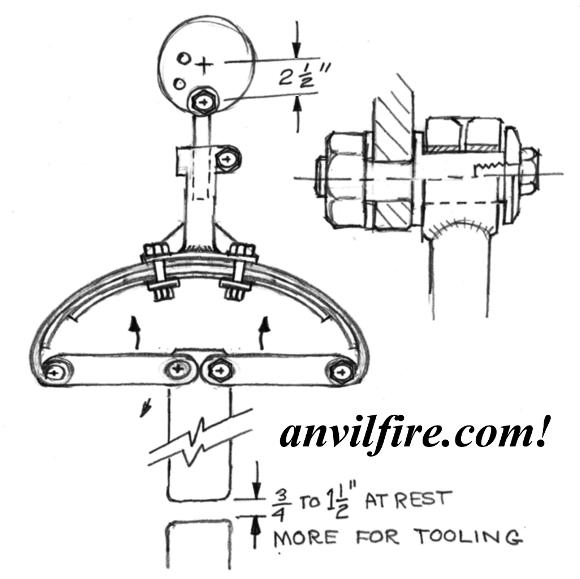| anvilfire! Power hammer Page 11 Page 1 Page 10 EC-JYH-2 CR-JYH Page 12 | |
Bow Spring Power Hammer Linkage
| |
|
The Drawing above shows one spring and toggle arrangement.
The springs shown are re-arced and reverse stacked trailer springs.
If custom made springs were used the eyes could be turned out instead of in as shown.
In commercial hammers with this type spring they are bent in a tall nearly rectangular "U" shape.
The springs must be preloaded sufficiently to support the ram with the toggles nearly horizontal. Note that due to the infinite leverage at the horizontal position the toggles will always sag 3 to 5 degrees. This requires about 5 to 6 times the ram weight in outward force. The total stroke of a Dupont toggle machine is twice the crank offset, plus the distance between dies and the upward stroke while compressing the spring. In the above that is: Note that the guides must support the ram for this distance PLUS the height adjustment. The height adjustment shown just below the crank is typical of commercial machines but is not always a good option for the hammer builder. Other ways to provide more work space is to use spacer blocks under the lower die. This works well with bolt on dies. Another possibility is to raise and lower the entire crank shaft and clutch mechanism. Stroke adjustment is not common on DIY hammers. However, it should be. On the CR-JYH that this sketch is based on the builder used a milled slot in the crank wheel. While this seems logical a series of holes is simpler and works better. The stroke adjustment is one that you do not make fine movements of. It is either full, minimum OR occasionally in the middle. All this requires is three holes. Using holes the parts are simpler and there is no chance of the adjustment slipping which is common on slotted designs. |
|
|
The Bow Spring Linkage gives the exact same action as the Dupont linkage of the Little Giant and used on the NC-JYH tire hammer but with less parts.
The leaf spring is both the arms and spring of the Dupont linkage.
The great advantage of the Dupont linkage that is not found in any other type of power hammer linkage is the smooth sinusoidal action and the reversing action that allows the spring to store energy at the top of the stroke and give it back on the way down. To work properly the toggles (side links) must be nearly horizontal or make a straight line at rest. At this point it requires very little motion at low speed for the hammer to strike gently. As the hammer speeds up the stroke increases, energy is stored in the spring and the hammer hits harder. |
|
|
Page 11
|
|